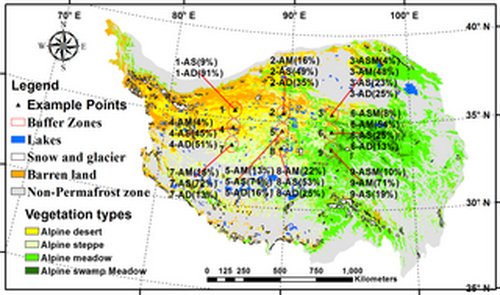The Qinghai-Tibetan Plateau (QTP) contains the largest permafrost area in a high-altitude region in the world, and the unique hydrothermal environments of the active layers in this region have an important impact on vegetation growth.
Geographical locations present different climatic conditions, and in combination with the permafrost environments, these conditions comprehensively affect the local vegetation activity. Therefore, the responses of vegetation to climate change in the permafrost region of the QTP may be varied differently by geographical location and vegetation condition.
In this study, using the latest Global Inventory Modeling and Mapping Studies (GIMMS) Normalized Difference Vegetation Index (NDVI) product based on turning points (TPs), which were calculated using a piecewise linear model, 9 areas within the permafrost region of the QTP were selected to investigate the effect of geographical location and vegetation type on vegetation growth from 1982 to 2012.
The following 4 vegetation types were observed in the 9 selected study areas: alpine swamp meadow, alpine meadow, alpine steppe and alpine desert. The research results show that, in these study areas, TPs mainly appeared in 2000 and 2001, and almost 55.1% and 35.0% of the TPs were located in 2000 and 2001. The global standardized precipitation evapotranspiration index (SPEI) and 7 meteorological variables were selected to analyze their correlations with NDVI.
We found that the main correlative variables to vegetation productivity in study areas from 1982 to 2012 were precipitation, surface downward long-wave radiation and temperature. Furthermore, NDVI changes exhibited by different vegetation types within the same study area followed similar trends.
The results show that regional effects rather than vegetation type had a larger impact on changes in vegetation growth in the permafrost regions of the QTP, indicating that climatic factors had a larger impact in the permafrost regions than the environmental factors (including permafrost) related to the underlying surface conditions.
This research achievement is published on PLOS ONE

Fig. Distribution of the four main vegetation types and 9 study areas (red circle) in the permafrost regions of the QTP.

